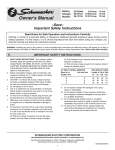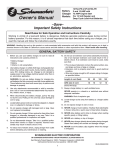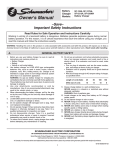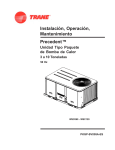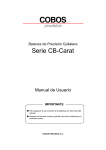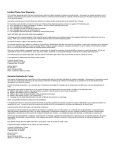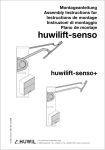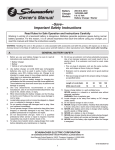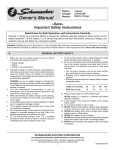Download Schumacher Electric SE-70MA Owner`s manual
Transcript
Battery Charger Model: Owner's Manual SE-70MA Fully Automatic Battery Charger 10-Amp, 12/24 Volt –Save– Important Safety Instructions Read Rules for Safe Operation and Instructions Carefully Working in vicinity of a lead-acid battery is dangerous. Batteries generate explosive gases during normal battery operation. For this reason, it is of utmost importance that each time before using your charger, you read this manual and follow the instructions exactly. WARNING: Handling the cord on this product or cords associated with accessories sold with this product, will expose you to lead, a chemical known to the State of California to cause cancer and birth defects or other reproductive harm. Wash hands after handling. A. 1. GENERAL BATTERY SAFETY Before you use your battery charger, be sure to read all instructions and cautions printed on: 10. Do not use an extension cord unless absolutely necessary. Use of an improper extension cord could result in fire or electric shock. If an extension cord must be used, make sure that: • Battery Charger • Battery • Vehicle or unit using battery 2. 3. 4. 5. 6. 7. 8. 9. • Pins on plug of extension cord are the same number, size, and shape as those of plug on charger. • Extension cord is properly wired and in good electrical condition. • Wire size is large enough for AC ampere rating of charger, as specified below: Use battery charger on LEAD ACID type rechargeable batteries only, such as used in autos, trucks, tractors, airplanes, vans, RV's, trolling motors, etc. Charger is not intended to supply power to low-voltage electrical system other than in an automotive application. WARNING: Do not use battery charger for charging dry-cell batteries that are commonly used with home appliances. These batteries may burst and cause injury to persons and damage to property. Use only attachments recommended or sold by manufacturer. Use of non-recommended attachments may result in fire, electric shock, or injury. When disconnecting the battery charger, pull by the plug not by the cord. Pulling on the cord may cause damage to cord or plug. Locate battery power cord so it cannot be stepped on, tripped over, or subjected to damage or stress. Do not operate charger with damaged cord or plug. Have cord replaced immediately. Do not operate charger if it has received a sharp blow, been dropped, or otherwise damaged in any way. Take it to a qualified professional for inspection and repair. Do not disassemble charger. Take it to a qualified professional when service or repair is required. Incorrect reassembly may result in electric shock or fire. To reduce risk of electric shock, unplug charger from outlet before attempting any maintenance or cleaning. AC INPUT RATING, AMPERES AWG SIZE OF CORD Equal to or but less than Greater than Length of Cord, Feet 25 50 100 150 0 2 6 2 3 8 18 18 18 18 18 16 18 16 12 16 14 10 11. Always charge battery in a well ventilated area. NEVER operate in a closed-in or restricted area without adequate ventilation. WARNING: Risk of explosive gas. 12. Locate charger as far away from battery as DC charger cables permit. 13. Do not expose charger to rain or snow. 14. NEVER charge a frozen battery. If battery fluid (electrolyte) is frozen, bring into a warm area to thaw before charging. 15. NEVER allow battery acid to drip on charger when reading specific gravity or filling battery. 16. NEVER set a battery on top of charger. 17. NEVER place charger directly above battery being charged. Gases from battery will corrode and damage charger. 18. NEVER touch the battery clamps together when the charger is energized. SCHUMACHER ELECTRIC CORPORATION 801 BUSINESS CENTER DRIVE • MOUNT PROSPECT, ILLINOIS 60056-2179 Send Warranty Product Repairs to: 1025 E. Thompson, Hoopeston, IL 60942-0280 Call Customer Service if you have questions: 1-800-621-5485 1 00-00-000318/0103 B. 1. 2. 3. 4. WARNING: Wear complete eye protection and clothing protection, when working with lead-acid batteries. Make sure someone is within range of your voice or close enough to come to your aid when you work with or near a lead-acid battery. Have plenty of fresh water and soap nearby for use if battery acid contacts skin, clothing, or eyes. If battery acid contacts skin or clothing, wash immediately with soap and water. Avoid touching your eyes while working with a battery. Acid particles (corrosion) may get into your eyes! If acid enters your eye, immediately flood eye with running cold water for at least 10 minutes. Get medical attention immediately. C. 1. 2. 3. 4. 5. 6. 7. PERSONAL PRECAUTIONS AND SAFETY 5. 6. 7. 8. Remove all personal metal items such as rings, bracelets, necklaces, and watches when working with a lead-acid battery. A lead-acid battery can produce a short-circuit current high enough to weld a ring (or the like) to metal, causing a severe burn. Take care not to drop a metal tool or other metal onto the battery. Metal may cause sparking or short circuit the battery or another electrical devise. Sparking may cause an explosion. Always operate battery charger in an open well ventilated area. NEVER smoke or allow a spark or flame in the vicinity of the battery or engine. Batteries generate explosive gases! PREPARING TO CHARGE Make sure you have a 12 or 24 volt lead-acid battery. Check car owner manual to make sure. Clean battery terminals. Take care to keep corrosion from coming in contact with your eyes. If required, add distilled water in each cell until battery acid reaches levels specified by battery manufacturer. This helps purge excessive gas from cells. Do not overfill. For a battery without cell caps, carefully follow manufacturer's recharging instructions. Study all battery manufacturer's specific precautions, such as removing or not removing cell caps while charging, and recommended rates of charge. Be sure area around battery is well ventilated while battery is being charged. Gas can be forcefully blown away by using a piece of cardboard or other non-metallic material as a fan. If necessary to remove battery from vehicle to charge, always remove grounded terminal from battery first. Make sure all accessories in the vehicle are off, so as not to cause an arc. A marine (boat) battery must be removed and charged on shore. To charge it on board requires equipment specially designed for marine use. When charging a battery in a RV or motor home always connect one lead of the output cable to the battery. Never connect to a remote receptacle or other means for the purpose of remotely charging the battery. The wires may be inadequate for handling the charge current of this charger and may over heat. Often these wires are bundled in with other wires which could be damaged and lead to a direct short across the battery and charger. If this occurs a fire can result, equipment and appliances operated from the battery may also be damaged. GROUNDED OUTLET ADAPTER METAL SCREW COVER OF GROUNDED OUTLET BOX GROUNDING PIN (A) (B) FIGURE 1: GROUNDING METHODS GROUNDING AND AC POWER CORD CONNECTION INSTRUCTIONS - Charger should be grounded to reduce risk of electric shock. Charger is equipped with an electric cord having an equipment-grounding conductor and a grounding plug. The plug must be plugged into an outlet that is properly installed and grounded in accordance with local codes and ordinances. DANGER - Before using adapter as illustrated, be certain that center screw of outlet plate is grounded. The green-colored rigid ear or lug extending from adapter must be connected to a properly grounded outlet - make certain it is grounded. If necessary, replace original outlet cover plate screw with a longer screw that will secure adapter ear or lug to outlet cover plate and make ground connection to grounded outlet. DANGER - Never alter AC cord or plug provided - if it will not fit outlet, have proper outlet installed by a qualified electrician. Improper connection can result in a risk of electric shock. Use of an adapter plug is not allowed in Canada. This battery charger is for use on a nominal 120-volt circuit, and has a grounding plug that looks like the plug illustrated in sketch A. A temporary adapter, which looks like the adapter illustrated in sketch B, may be used to connect this plug to a two-pole receptacle as shown in sketch B if a properly grounded outlet is not available. The temporary adapter should be used only until a properly grounded outlet can be installed by a qualified electrician. During operation do not place the charger or its cables on the vehicle seat or carpeting. 2 D. BATTERY CHARGER CONTROLS NOTE: A buzz, or hum is normal when the output cables have been disconnected and the AC power cord is still connected to an electrical source (i.e. wall outlet). If more than one battery is to be charged, be sure the total battery voltage is not less than that of the charger or damaged could result to batteries and charger. Diagram for series hook up is shown below: OPERATION – Model SE-70MA Two switches permit operation and volt selection. Switch #1 – OPERATION SELECTOR Mode 1 – Manual setting: Warning: This charging must be monitored and stopped when the battery is charged. Overcharging will damage the battery. Mode 2 – Automatic setting for Conventional and Low Maintenance Batteries. If you are not sure of your battery type, use the Conventional setting. Mode 3 – Automatic setting is for Maintenance Free and Deep Cycle batteries. Use #10 AWG jumper wires to connect batteries. Switch #2 – VOLT SELECTOR Select either the 12 or 24-volt setting: Use the 12-volt setting for a 12-volt battery and the 24-volt setting for two 12-volt batteries hooked up in series. VOLT SELECTOR OPERATION SELECTOR AUTOMATIC FOR ▼ ▼ MAINTENANCE FREE AND DEEP CYCLE (SWITCH #1) BATTERIES MANUAL ▲ AUTOMATIC FOR CONVENTIONAL AND LOW MAINTENANCE BATTERIES E. 1. (SWITCH #2) ▲ 12 VOLT ▲ 24 VOLT DC CONNECTION PRECAUTIONS Connect and disconnect DC output clamps only after setting any charger switches to off position and removing AC cord from electric outlet. Never allow clamps to touch each other. F. 2. FOLLOW THESE STEPS WHEN BATTERY IS INSTALLED IN VEHICLE GROUND (NEG) A SPARK NEAR BATTERY MAY CAUSE BATTERY EXPLOSION. FOLLOW THESE STEPS TO REDUCE RISK OF SPARK NEAR BATTERY: 1. 2. 3. 4. 5. 6. Attach clamps to battery posts and twist or rock back and forth several times to make a good connections This tends to keep clamps from slipping off terminals and helps to reduce risk of sparking. Position AC and DC cords to reduce risk of damage by hood, door, or moving engine part. Stay clear of fan blades, belts, pulleys, and other parts that can cause injury to persons. Check polarity of battery posts. POSITIVE (POS, P,+) battery post usually has larger diameter than NEGATIVE (NEG, N, ) post. Determine which post of battery is grounded (connected to the chassis). If negative post is grounded to chassis (as in most vehicles), see No. 5. If positive post is grounded to the chassis, see No. 6. For a negative-grounded vehicle, connect POSITIVE (RED) clamp from battery charger to POSITIVE (POS, P,+) ungrounded post of battery. Connect NEGATIVE (BLACK) clamp to vehicle chassis or engine block away from battery. Do not connect clamp to carburetor, fuel lines, or sheetmetal body parts. Connect to a heavy gage metal part of the frame or engine block. (Figure 2) For a positive-grounded vehicle, connect NEGATIVE (BLACK) clamp from battery charger to NEGATIVE (NEG, N, -) FIGURE 2: CONNECTION TO NEGATIVE GROUNDED BATTERY 7. 8. 3 ungrounded post of battery. Connect POSITIVE (RED) clip to vehicle chassis or engine block away from battery. Do not connect clamp to carburetor, fuel lines, or sheet-mebl body parts. Connect to a heavy gage metal part of the frame or engine block. (Figure 3) When disconnecting charger, disconnect AC cord, remove clamp from vehicle chassis, and then remove clamp from battery terminal, in that order. See charge period for length of charge information. G. G. FOLLOW THESE STEPS WHEN BATTERY IS OUTSIDE VEHICLE A SPARK NEAR THE BATTERY MAY CAUSE BATTERY EXPLOSION. TO REDUCE RISK Of A SPARK NEAR BATTERY: POSITIVE Check polarity of battery posts. POSITIVE (POS, P,+) battery post usually has a larger diameter than NEGATIVE (NEG, N, -) post. 2. Attach at least a 24-inch-long 6-gauge (AWG) insulated battery cable to NEGATIVE (NEG, N, -) battery post (not H.provided). 3. Connect POSITIVE (RED) charger clamp to POSITIVE (POS, P,+) post of battery. 4. Position yourself and free end of cable as far away from battery as possible - then connect NEGATIVE (BLACK) charger clamp to free end of cable. 5. Do not face battery when making final connection. 6. When disconnecting charger, always do so in reverse sequence of connecting procedure and break first connection while as far away from battery as practical. 7. A marine (boat) battery must be removed and charged on shore. To charge a battery on the boat requires equipment specially designed for marine use. NEGATIVE 1. H. CHARGER BATTERY POWER CORD 24" 6 GAUGE CABLE TO GROUNDED POWER OUTLET FIGURE 3: CONNECT NEGATIVE BATTERY CLIP TO 24 INCH CABLE END AC POWER CORD CONNECTION INSTRUCTIONS DANGER - Never alter AC cord or plug provided - if it will not fit outlet, have proper outlet installed by a qualified electrician. Improper connection can result in a risk of an electric shock. This battery charger is for use on a nominal 120-volt 60 Hz circuit. I. 1. OPERATION INSTRUCTIONS These battery chargers are equipped with a self-resetting circuit breaker. This device protects the charger from temporary overloads. In the event of an overload, the circuit breaker will trip open, and after a short cooling off period, will reset automatically. This process is known as cycling and can be recognized by an audible clicking sound. J. 2. These battery chargers are equipped with an electronic control circuit which automatically governs the charge rate to your battery. The charger will satisfactorily charge Maintenance Free and Conventional batteries. OUTPUT VOLTAGE This charger is for use with 12 volt lead-acid batteries. The SE-70MA is for 12 and 24 volt systems. K. INDICATION OF PROPER OPERATION TO A DISCHARGED BATTERY BUT OTHERWIDE IN GOOD CONDITION 10 Amp 12 Volt setting: The initial charge current should be 10 amps gradually tapering throughout the charge cycle to 5 amps. Though not indicated, battery voltage will gradually rise to approximately 14.3 volts, then hold constant throughout remainder of charge cycle. When the battery reaches 14.3 volts and charge current drops to 5 amps the charger will turn off. Initially the battery voltage will drop from its 14.3 volt level fairly quickly. When 13 volts is reached, the charger will again turn on, until the 14.3 volt, 5 amp condition is met. As this action continues, on time will decrease to a few seconds while off time increases to a range of several minutes to an hour. on/off times vary with size, type and condition of battery. 4 L. CHARGE PERIOD The approximate required time to bring a battery to full charge state depends upon the number of ampere hours (AH) depleted from the battery. AHs are determined by multiplying the number of hours by the number of amps supplied to a load. 2. 3. For example - If a load was connected to a battery, which drew 7 amps for a period of 5 hours, the battery will have supplied 35 AH. The approximate recharge time would then be calculated by dividing the 35 AH depleted from the battery, by the ampere charge rate of the charger. To allow for tapering off of the charge rate, add 25 percent to the charge time. 4. Indications of a fully charged battery are: 1. 5. When the meter indicates an intermittent current flow to the battery. N. A hydrometer reading of the specific gravity of the electrolyte (fluid) of a battery in good condition should be between 1.250 and 1.285. When a battery reaches 80-85% of full charge, bubbles will appear on the surface of the fluid. As the battery nears full charge, bubbling will become more noticeably active. The time required to charge two 6-volt batteries connected in series will be the same as for one 12-volt battery of equivalent size. NOTE: This charger will shut off when the battery is fully charged and will turn back on automatically when the battery needs to be charged again. Do not charge two 12-volt batteries in parallel. STORAGE Store battery charger in a dry area. M. TROUBLESHOOTING The battery charger is designed to work automatically. However, If a problem does occur, check the following: PROBLEM POSSIBLE CAUSE SOLUTION No meter reading. Connections are reversed. With charger unplugged, reverse clamps and reconnect (rock back and forth to bite in). Poor electrical connection. (Rock clamps back and forth to bite in.) Clean clamps and battery posts and reconnect AC outlet is dead. Plug in a lamp or other appliance to check for voltage. Battery is defective (will not accept charge). Have battery checked. Charger will not turn on (when properly connected to power. Battery recently charged as result of driving and is fully charged. Battery does not need charging. (Turning on headlights will lower battery voltage in a few seconds and charger should then turn on.) Charger will not turn OFF. Battery has problem and will not take full charge. Have battery checked. Meter needle pulses (fluctuates)every few seconds AFTER THREE HOURS without slowing down. Two or more batteries connected in parallel. Do not parallel charge. Battery of 200 ampere hours or larger. Requires more time to charge: continue charging. Battery is connected to applicaton that draws a small current (such as an interior light). Meter needle moves to extreme right, remains a short time, then returns to zero, accompanied by a clicking sound. Severely discharged battery (but otherwise good battery). Allow charging to continue until battery has recovered sufficiently to take a charge. (Circuit breaker will continue to cycle and needle will swing side to side until battery has recovered.) Battery is defective (will not accept charge). Have battery checked. Charger is cycling after circuit breaking overload. Wait until charger automatically resets itself (DO NOT RETURN FOR SERVICE). 5 LIMITED WARRANTY SCHUMACHER ELECTRIC CORPORATION, 801 BUSINESS CENTER DRIVE, MOUNT PROSPECT, ILLINOIS, 60056-2179 MAKES THIS LIMITED WARRANTY TO THE ORIGINAL PURCHASER AT RETAIL OF THIS PRODUCT. THIS LIMITED WARRANTY IS NOT TRANSFERABLE. Schumacher Electric Corporation warrants this battery charger for 2 years from date of purchase at retail against defective material or workmanship. If such should occur, the unit will be repaired or replaced at the option of the manufacturer. It is the obligation of the purchaser to forward the unit together with proof of purchase, transportation and / or mailing charges prepaid to the manufacturer or its authorized representative. This limited warranty is void if the product is misused, subjected to careless handling, or repaired by anyone other than the factory or other authorized factory representative. The manufacturer makes no warranty other than this limited warranty and expressly excludes any implied warranty including any warranty for consequential damages. This is the only express limited warranty and the manufacturer neither assumes nor authorizes anyone to assume or make any other obligation towards the product other than this express limited warranty. The manufacturer makes no warranty of merchantability or fitness for purpose of this product and expressly excludes such from this limited warranty. Some states do not allow the exclusion or limitation of incidental or consequential damages or length of implied warranty so the above limitations or exclusions may not apply to you. “This warranty gives you specific legal rights, and you may have other rights which vary from state to state.” 6 NOTES 7 A. INSTRUCCIONES IMPORTANTES DE SEGURIDAD: 1. 2. 3. 4. 5. 6. 7. 8. 5. GUARDAR ESTAS INSTRUCCIONES de este manual, el cual contiene todas las instrucciones necesarias para trabajar estos cargadores de baterías. Antes de usar su cargador de baterías lea todas las instrucciones y letreros de precaución (1) en el cargador, (2 ) en la batería, y (3) producto usando la batería. PRECAUCION: Para reducir los riesgos de daños, cargue solamente la batería del tipo de plomo ácido y recargable. Otros tipos de baterías pueden explotar y causarles daños físicos y perdidas. No exponga el cargador de batería a lluvia o nieve. Si usan algún equipo que no sea recomendado o vendido por el fabricante, puede producir un fuego o sacudida eléctrica o daños físicos a la persona que lo use. Para reducir el riesgo de daños hacia el cordón y toma-corriente cuando vayan a desconectar ese cordón de toma-corriente no jalen el cordón sino jalen el enchufe, esto es cuando vayan a desconectael cargador de baterías del enchufe de la corriente. Tengan cuidado donde guardan el cordón, no deje que ninguna persona camine sobre el mismo, lo jale o lo dañe. No usar cables de extensión a no ser que sea absolutamente necesario. El uso de una extensión inapropiada, puede resultar en que el cable es muy largo y muy fino al subir el amperaje puede haber fuego o sacudida eléctrica. Si tienen que usar alguna extensión asegúrense de lo siguiente: (a)Que los ganchos del enchufe sean del mismo número, tamaño y figura que los del cargador. (b) Que la extensión esté en buenas condiciones. (c) Que el tamaño de los cables sea lo suficientemente grueso en calibre, para la proporción de ampares de corriente alterna, que pasen a traves de la misma y según lo especifican los siguientes datos: PROPORCION DE AMPARES DE 6. 7. 8. 9. D. PREPARATIVOS PARA CARGAR 1. 2. 3. 4. 5. 6. 7. Grueso o calibre del cordón el CORRIENTE ALTERNA tamaño del cordón en pies Igual a : : o mayor que pero menor que 25 50 100 150 0 2 18 18 18 16 2 3 18 18 16 14 6 8 18 16 12 10 9. No opere el cargador con un cordón dañado, cámbielo inmediatamente. 10. No use el cargador si ha recibido un golpe fuerte, o si se le ha caído o dañado en cualquier forma; llevarlo a un taller para que lo reparen y que sea un técnico que conozca de estos productos, para que le hagan un buen trabajo en la batería. 11. No desarmar el cargador, llevarlo a un taller de técnicos capacitados que conozca estos equipos. Si lo instala mal puede causar fuego o sacudida eléctrica. 12. Para reducir los riesgos de sacudidas eléctricas desconecte el cargador del toma-corriente, antes de intentar limpiarlo. Apagar los controles no es suficiente para prevenir los daños. POSICION DEL CARGADOR 1. Coloque el cargador lejos de la batería. Lo más lejos que permita el cable. Nunca sitúe el cargador directamente encima de la batería, cuando la cargue. Los gases de la batería dañarán el cargador. Nunca permita que el ácido de la batería, gotee sobre el cargador cuando llene la batería y pueda caer por gravedad sobre la misma. No opere el cargador en un área cerrada restringida de ventilación. No coloque la batería sobre el cargador. No deje que le caiga lluvia ni nieve al cargador. Los cargadores de batería se ponen bien calientes mientras funcionan y requieren la debida ventilación. Es esencial que el aire fluya alrededor del cargador entero. No coloque el cargador sobre cosas inflamables tales como alfombras, tapicería, papel, cartón, etc. El cargador puede dañar el cuero y derretir el plástico y el caucho. 2. 3. 4. 5. 6. 7. 8. 2. Trabajar en su vecindario con una batería de plomo ácido es muy peligroso. Estas baterías generan gases explosivos durante su trabajo normal. Por esta razón es muy importante que antes de usar el cargador, lean el manual y sigan las instrucciones exactas. Para reducir los riesgos de explosión siga estas instrucciones y las instrucciones que fabricante de baterías y cualquier otro equipo que vayan a usar. Repasen los mensajes de prevención en estos equipos. F. 2. 3. 4. CONTROLES DEL CARGADOR DE BATERÍAS NOTA: Cuando la batería se acerca al estado de plena carga, la aguja del amperímetro y la LED se fluctúan entre CHARGED y CHARGING. Para el tamaño promedio de batería de automóvil, espere de 5 a 10 minutos para que la batería se estabilice. OPERACION–Modelo SE-70MA C. PRECAUCIONESPERSONALES 1. Si tiene que quitar la batería del carro para darle carga, (1) siempre quite el terminal que hace tierra, (2) asegúrese que todos los accesorios del carro estén apagados. Asegúrese que el área donde esté cargando la batería, esté bien ventilada mientras que está dando carga. El gas se puede eliminar con un cartón y usándolo como abanico. Limpie los terminales de la batería, cuidando que no le caiga ninguna substancia corrosiva en los ojos. Añadan agua destilada a las células de la batería hasta el nivel que el fabricante especifica. Esto le ayuda a botar el gas excesivo de las células. No la sobre llene. Para baterías sin tapa siga las instrucciones de dar carga cuidadosamente. Estudie todas las precauciones que el fabricante les especifica mientras que carga la batería. También la proporción de carga que debe darle. Determine el voltaje de la batería de acuerdo al Manual del carro y asegúrese que el interruptor de selección de voltaje marque el voltaje correcto. Si la batería tiene una proporción de carga ajustable, empiece por la carga menos fuerte. ADVERTENCIA - El manejo del cordón en este producto, o de los cordones asociados con los accesorios vendidos con este producto, le expone a usted al plomo, un producto químico conocido en el Estado de California de causar cáncer y defectos de nacimiento u otros daños reproductivos. Lávese las manos después de manejar estos cordones. E. B. ADVERTENCIA - RIESGOS CON GASES EXPLOSIVOS 1. Nunca fume, ni encienda una llama cerca de la batería o del motor de su carro. Tenga cuidado de no dejar caer herramienta metálica encima de la batería, este puede causar un corto circuito y explotar la batería. Quítese todos los metales personales, tales como anillos, brazaletes, collares, relojes, mientras este trabajando con una batería. Una batería de plomo ácido puede producir un corto circuito tan alto como para soldar un anillo de metal y causarle una quemadura muy grave. Use el cargador para cargar una batería de plomo ácido, no sirve para ningún otro tipo de equipo de voltaje pequeño, sólo para el automóvil. No use el cargador para baterías caseras porqué explotan. NUNCA cargue una batería que esté congelada. Dos interruptores que permiten la operación y selección de voltaje. Debe estar alguien cerca o al alcance suyo cuando trabaje en una de estas baterías (de plomo ácido). Tenga agua fresca con jabón cerca por si acaso le cae el ácido en la piel, en la ropa, o en los ojos. Use el protector completo para protegerse los ojos y la ropa. Evite tocarse los ojos cuando este trabajando cerca de las baterías (de plomo ácido). Si cayese ácido en la piel o en la ropa, lávelo inmediatamente con jabón y agua. Si el ácido le cae en los ojos, enjuáguese inmediatamente con agua fría por unos 10 minutos o más, luego llame al Doctor o busque asistencia médica. Interruptor #1–SELECTOR DE OPERACION Modo 1–Opción Manual: Advertencia: Este tipo de carga debe ser supervisado constantemente y apagado cuando la bateria haya sido cargada. Una sobrecarga puede dañar la batería. Modo 1–Opción Automática, para Baterías Convencionales y de Poco Mantenimiento. Si usted no esta seguro del tipo de batería que va a cargar, se recomienda que seleccione tipo Convencional. Modo 3–La opción Automática, también se recomienda para baterís Libres de Mantenimiento (selladas) y de Ciciaje Profundo. 8 Interruptor #2–SELECTOR DE VOLTAJE Seleccione entre 12 o 24-voltios: Dependiendo el número de baterias que vaya a cargar. Por ejemplo: En 12 voltios para una batería de 12 voltios y 24 para dos del mismo voltaje conectadas en serie. 6. SELECTOR DE OPERACION MANUAL ▼ AUTOMATICO PARA BATERIAS ▼ LIBRES DE MANTENIMIENTO (Selector #1) Y DE CICLAJE PROFUNDO 7. ▲ 8. AUTOMATICO PARA BATERIAS CONVENCIONALES DE BAJO MANTENIMIENTO I. SIGA ESTOS PASOS CUANDO LA BATERIA ESTE FUERA DEL VEHICULO. CUANDO LA BATERIA ESTA SITUADA FUERA DEL VEHICULO: 1. Compruebe la polaridad de los postes de la batería. El poste positivo generalmente tiene un diámetro más grande que el poste negativo. Si no son identificados como (+) (-). Adjunte un cable de batería aislado por lo menos de 24" de largo y de calibre 6 al poste negativo. Conecte los alicates del cargador positivo rojo al poste positivo de la batería. Sitúese usted y la parte libre del cable lo más lejos posible de la batería, entonces conecte el poste del cargador negativo negro al.extremo libre del cable. No se acerque a la batería cuando haga la conexión final. Cuando desconecte el cargador siempre hágalo en secuencia reversa en la forma que lo conectó, yendo desde el paso final hasta el paso inicial, y cuando desconecte la primera conexión hágalo lo más lejos posible de la batería. Una batería marina tiene que quitarse y cargarse en la tierra. Para cargarla en el barco lleva un equipo especial para uso marítimo. SELECCION DE VOLTAJE (Selector #2) ▲ 24 VOLTIOS ▲ 12 VOLTIOS 2. 3. Si usted va a cargar más de una batería en serie, asegurese de que el voltaje total de estas no sea menor al voltaje seleccionado en el cargador, un error en esta operación podría dañar tanto el cargador como las baterias. El diagrama en la parte inferior le muestra la conección correcta: 4. 5. 6. + ROJO +• •—CABLE DE CARGADOR 7. CONDUCTOR •- - NEGRO +• J. CABLES DE DE 24" CONECCION EN SERIES Use cable de calibre #10 para conectar las baterias una entre otra. Este cargador de batería es para uso nominal de 120 voltio 60. G. PRECAUCIONES PARA CONECCIÓN DE CORRIENTE DIRECTA (DC) 2. K. INSTRUCCIONES DE OPERACION 1. Conecte y desconecte los clips de salida de corriente DC del acumulador, únicamente después de haber apagado los interruptores y haber removido el cordón de corriente AC del toma-corriente, nunca permita que se toquen los dos terminales. Una los terminales a los postes de la batería y enrósquelos varias veces para tener una buena conexión. Esto previene que se salgan los terminales de los clips de la batería y reduce los riesgos de chispa. 2. H. SIGA LOS PASOS CUANDO INSTALE LA BATERIA EN EL CARRO. UNA CHISPA CERCA DE LA BATERIA PUEDE CAUSAR UNA EXPLOSION. PARA REDUCIR LOS RIESGOS DE LA CHISPA CERCA DE LA BATERIA HAGA LO SIGUIENTE: 1. 2. 3. 4. 5. INSTRUCCIONES DE TIERRA Y CONEXION DEL CABLE DE CORRIENTE ALTERNA DEL TOMA-CORRIENTE: PELIGRO - Nunca altere el cable o interruptor que viene con el equipo. Si ese toma-corriente no cabe en el toma-corriente instalado en el lugar donde usted quiera cargar el cargador de baterías, tiene que usar una conexión especial, tal y como se muestra en las instrucciones. CONDUCTOR 1. No conecte los alicates al carburador, lineas de gasolina u hojas de metal del cuerpo del carro. Conecte un metal fuerte del marco del bloque del motor. Para vehículos que tienen tierra positivo (+), conecte los alicates (-) negativo negro del cargador al poste negativo de la batería. Conecte los alicates positivo ( + ) rojo al chasis del vehículo o al bloque del motor lejos de la batería. No conecte este alicate del cargador al carburador, lineas de gasolina u hojas de metal del carro. Conecte solamente al marco de metal grueso del bloque del motor. Cuando vaya a desconectar el cargador desconecte el cordón de la corriente AC del toma-corriente y después quite los alicates del chasis y de la batería en este mismo orden. Observe las instrucciones de trabajo para información sobre el tiempo de carga. Estos cargadores de batería están equipados con un rompedor automático. El cual protege el cargador de sobre cargas innecesarias. En el caso que se recargué la linea eléctrica, el rompe circuito se dispara, y después de enfriar vuelve arrancar automáticamente. Este proceso se llama ciclo y se puede reconocer porque hace un sonido audible. Estos cargadores de batería, están equipados con un circuito de control electrónico que automaticámente manda el tipo de carga de su batería. Este cargador satisfactoriamente cargará su manutención exenta así como baterías convencional. L. LOS VOLTAJES DE SALIDA Este cargadores son para baterías de 12 voltios solamente. M. TIEMPO DE CARGA Sitúe los cordones de corriente AC y DC. Para reducir riesgo de daño por gancho puerta o movimiento por parte del motor. Manténgase lejos de las paletas de un ventilador, correas u otras piezas que puedan causarle daño a las personas. Chequee la polaridad de los postes de la batería, ya que toda batería tiene dos postes, uno positivo y el otro negativo señalado como signo + o signo - . Casi siempre tienen un diámetro más grande los positivos que los negativos. Determine cuál de los postes es el que hace tierra y que van conectados al chasis del carro. Si el poste negativo hace tierra con el chasis (Como en casi todos los automóviles, siga las instrucciones del No. 5). Si el poste positivo ( + ) hace tierra con el chasis, siga las instrucciones del No. 6. Para vehículos con tierra negativa (-), conecte la tenaza (+) positiva roja al poste positivo (+ ) sin tierra de la batería. Conecte la clip del cable negativo negro al chasis del carro o motor lejos de la batería. Para batería mas grande cualquier colocación puede ser usarla. N. INDICACION APROPIADA PARA CARGAR UNA BATERIA DESCARGADA QUE ESTA EN BUENAS CONDICIONES: 1. 9 Ponga "10 AMP": La carga de corriente deberá ser 10 AMP’s y gradualmente reduciendo a 5 AMP's durante el ciclo de carga. Aunque no está indicado, el voltaje en la batería gradualmente irá subiendo a 14.3 voltios y se detiene allí durante el resto del ciclo que carga. Cuando la batería llega a 14.3 voltios y la corriente de carga baja a 4 AMP’s el cargador se apaga. Inicialmente el voltaje de la batería baja al estado de 14.3 AMP rápidamente. Cuando llega a 13 voltios el cargador arrancará de nuevo hasta llegar a 14.3 voltios, 5 AMP’s. A la vez que continúe esta acción, el tiempo "ON" disminuirá a unos pocos segundos, mientras el tiempo "OFF" aumentará hasta unos cuantos minutos o una hora. Tiempos "ON" o "OFF" varían depender del tamaño, tipo o condiciones de la batería. O. TIEMPO DE CARGA: 3. El tiempo que requiere la batería para cargarse depende de la cantidad de ampares que está señalado en la batería. 4. Los ampares hora son determinados de la siguiente forma: Multiplique el número de horas de carga x el número de ampares suplido por la batería a la carga. Cuando la carga de batería llega a 80-85% de cargada llena, burbujas aparecerán en la superficie del líquido. A la vez que la batería acercarse a cargado lleno, las burbujas serán más vigorosas. El tiempo para cargar dos baterías de 6 voltios conectados en series será igual a una batería de 12 voltios del mismo tamaño. ANOTE: El cargador de batería es protegido de polaridad; so se encenderá si este conectado impropiamente a lasbaterías o si las baterías no tienen voltaje. Este cargador se apagará cuando se completa la carga en la batería y prenderá automáticamente cuando es necesite cargar la batería. Por ejemplo: Si se le dio una carga a la batería de 7 ampares por 5 horas, la batería suplió 35 ampares. Luego el tiempo de descarga se calcula con dividir los 35 ampares por la proporción de carga en ampares del cargador. Para calcular el tiempo célale el 25% de la proporción de carga al tiempo de carga. P. ALMACENAMIENTO Guarde el cargador de baterías en un lugar seco. Las indicaciones de que ya tomó la carga es como sigue: 1. 2. Cuando el medidor indica un intermitente de corriente a la batería. Una muestra de hidrómetro enseña gravedad específica que tiene el electrolito (líquido) de una batería que está en buenas condiciones debe de estar entre 1.250 y 1.285. SOLUCION DE PROBLEMAS El cargador de batería está diseñado para funcionar automáticamente. Sin embargo, si se presenta un problema, chequee lo siguiente: PROBLEMA POSIBLE EXPLICACION SOLUCION No hay lectura en el medidor Conexiones están invertidas Con el cargador desenchufado, invierte las grapas y reconecte (muévalas adelante y atrás para que cojen bien). Limpie las pinzas y los polos de la batería y reconecte (muévalas adelante y atrás para que cojen bien). Enchufe una lámpara u otro aparato para buscar voltaje Haga revisar la batería. Mala conexión eléctrica Tomacorriente CA está muerta. La batería es defectuosa (no acepta carga) El cargador no enciende (al estar debidamente conectado a la energía) La batería fue usada últimamente en el vehículo y está a plena carga La batería no necesita cargarse. (Si la batería stá en el vehículo, el encender las luces hará bajar el voltaje de la batería en pocos segundos y entonces el cargador debe encenderse). El cargador no se APAGA La batería tiene problema y no acepta plena carga. Haga revisar la batería. La aguja del amperimetro pulsa (fluctúa) cada dos o tres segundos DESPUES DE TRES HORAS sin disminuir. Hay dos baterías o más conectadas en paralelo. No cargue en paralelo. Es batería de 200 amperio horas o más Requiere más tiempo para cargarse; siga cargando. La batería está conectada a una aplicación que requiere poca corriente (tal como la luz de techo de un carro) La aguja del ampímetro se mueve a la extrema derecha, se queda corto tiempo, luego vuelve a cero, acompañado de un sonido a clic! Batería bien descargada (pero aparte de eso, es buena batería) La batería es defectuosa (no acepta carga) El cargador está ciclando después de una sobrecarga que hizo disparar el disyuntor. 10 Siga cargando hasta que la batería se haya recuperado lo suficiente para aceptar una carga (El disyuntor seguirá ciclando y la agua se moverá de un lado a otro hasta que la batería se haya recuperado) Haga revisar la batería. Espere hasta que el cargador se reponga automáticamente. (NO LO DEVUELVA PARA SERVICIO). GARANTÍA LIMITADA SCHUMACHER ELECTRIC CORPORATION, 801 BUSINESS CENTER DRIVE, MOUNT PROSPECT, IL 60056-2179, OTORGA ESTA GARANTIA LIMITADA AL COMPRADOR MINORISTA ORIGINAL DE ESTE PRODUCTO. ESTA GARANTIA LIMITADA NO ES TRANSFERIBLE. Schumacher Electric Corporation garantiza este cargador de batería por dos años a partir de la compra minorista por material o mano de obra defectuosos. La unidad será reparada o reemplazada a la opción del fabricante de ocurrir lo anterior. Es obligación del comprador enviar la unidad con prueba de compra, con los cargos de transporte y/o franqueo postal pagos al fabricante o a su representante autorizado. La garantía limitada es nula si el producto se ha usado mal, ha sido sujeto a un manejo descuidado o ha sido reparado por alguna persona distinta al fabricante o su representante autorizado. El fabricante no efectúa ninguna representación distinta a esta garantía limitada y expresamente excluye cualquier garantía implícita incluyendo cualquier garantía por daños consecuentes. ESTA ES LA UNICA GARANTIA EXPRESA LIMITADA Y EL FABRICANTE NO ASUME NI AUTORIZA A NADIE A ASUMIR CUALQUIER OTRA OBLIGACION CON RESPECTO AL PRODUCTO DISTINTA A ESTA GARANTIA EXPRES A LIMITADA. EL FABRICANTE NO OTORGA NINGUNA GARANTIA DE COMERCIALIZACION O ADAPTABILIDAD DE ESTE PRODUCTO Y EXCLUYE EXPRESAMENTE AQUELLAS DE ESTA GARANTIA LIMITADA. ALGUNOS ESTADOS NO PERMITEN LA EXCLUSION O LIMITACION DE DAÑOS INCIDENTALES O CONSECUENTES O LA DURACION DE LA GARANTIA IMPLICITA DE MANERA QUE LAS LIMITACIONES O EXCLUSIONES EXPUESTAS ARRIBA PUEDEN NO APLICARSE A USTED. ESTA GARANTIA LE OTORGA DERECHOS LEGALES ESPECIFICOS Y USTED PUEDE TENER TAMBIEN OTROS DERECHOS QUE VARIAN DE ESTADO A ESTADO. 11 NOTAS 12
This document in other languages
- español: Schumacher Electric SE-70MA












